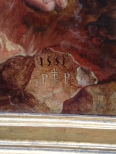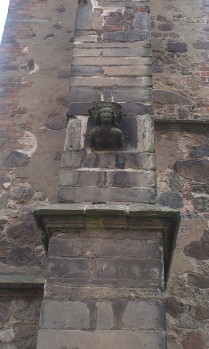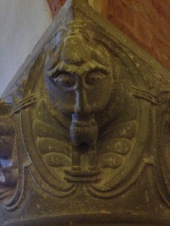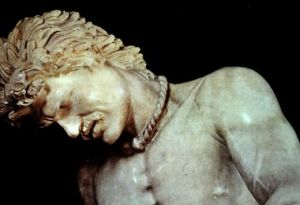Gedachten rond Ymir en de kosmogonische mythe
I’ve published a new article about Ýmir.It is written in Dutch but you can try to translate it with google. Click here to read the full article.
Gallo-Roman Museum Velzeke
The gallo-roman museum in Velzeke in Flanders is worth a visit. It has some nice artifacts on display, although the description about the artifacts is sometimes very cumbersome. I made some pictures of for me interesting artifacts.
All pictures by J. De Cooman. You can reuse the pictures freely. Drop me a small note when you publish them.
Heathen Symbols in Bruges
Bruges is a very beautiful, medieval city in Flanders, Belgium, which is literally a paradise for those who love old symbolism. I’ve just added some pictures taken during my last trip there.
All pictures by J. De Cooman. You can reuse the pictures freely. Drop me a small note when you publish them.
Heathen Symbols in Zerbst
The town of Zerbst in Sachsen-Anhalt, Germany, was a very important town during the 14th and 15th century. As one of the oldest towns, the city had a couple of very old churches and other noteworthy buildings. Unfortunately most of the city was destroyed by inhuman, anglo-american attacks during the second world-war. Only a few ruins remained after this act of cultural vandalism. Some heathen symbols on the walls of church remained but are doomed to disappear forever in a couple of years. The Nicolai-church, of which only the walls remain, has a lot of interesting symbols and figures on it. Note that Nicolai is related to the cult of Odin/Wodan [Hnikar]. One particular well-preserved sculpture on the Nicolai-church is the so-called Judensau.
All pictures by J. De Cooman. You can reuse the pictures freely. Drop me a small note when you publish them.
Heathen Symbols in Breda
The city of Breda, Noord-Brabant, Netherlands, has a very rich history. During a visit I couldn’t resist to hunt for symbols in one of the oldest churches there. The Onze-Lieve-Vrouwekerk was built around 1410, probably on a (heathen) sacred site dedicated to the “Allmutter”. Although the church doesn’t have too much symbols, I found some surprises.
All pictures by J. De Cooman. You can reuse the pictures freely. Drop me a small note when you publish them.
Symbols in Monastery Jerichow
The Monastery in Jerichow (Sachsen-Anhalt, Germany) was built around the 12th century in the vicinity of the Elbe river. The monastery is one of the oldest Romanesque brick style buildings in the area. Once there was a castle there too, but it was destroyed. The building inside has been stripped of almost all symbols, but in the cellar some old symbols survived. The predominant symbol is the tree of life.
I can’t truly say in which period the artifacts with the symbols were made, but the ones in the cellar surely look like they have been there since the very beginning. Some of them have been partly destroyed. Maybe because of the heathen background, maybe it was religious or political vandalism during the different wars around the 16th century. It’s nearly impossible to say. Nevertheless, these symbols find their origin in the heathen world of our ancestors.
All pictures by J. De Cooman. You can reuse the pictures freely. Drop me a small note when you publish them.
Torcs and divine Subjugation

A team of archeaologists has been excavating a burial site since 2013 near Saintes in Southern France. Between September and November 2014, they unearthed a necropolis with hundreds of Gallo-Roman graves. A couple of months ago, the archaeologists discovered skeletons showing evidence of shackling.
Almost all of the excavated burials yielded no grave goods expect for the grave of a young child in which vases dated to the second half of the 2nd century were deposited. This burial, also contained two coins, placed on the eyes of the child. The funerary practice for this grave is very different from those observed from the other burials identified at this site.
Even more interesting is that four adults had shackles on their right ankle, while the fourth also had a collar around the neck. A child also had a more rudimentary riveted object around his left wrist.
Wearing a collar around the neck, like a iron, bronze or golden torc, is common in Europe. It is distributed in time and space starting from the bronze age. Finding show that the torcs were particularly common among the Celtic tribes, but it was also widely known among the Germanic tribes as the geographical spread of the findings suggests.
A Celtic coin hoard discovered in Jersey, announced in December 2014, has been astounding archaeologists with a series of gold treasure finds. The treasure contained two solid gold torcs – one gold-plated and one of an unknown alloy – along with a silver brooch and a crushed sheet gold tube. One end of a solid gold torc was uncovered. The torc has a massive decorative ‘terminal’, which is where it was probably locked closed around the owner’s neck. The terminal is formed from two solid gold wheels, each about 4cm across and 1cm wide. The find can be compared to various other finds throughout Europe.
One of the most famous statues wearing a collar around his neck, is the one of the dying Galatian. But is was not limited to Celtic tribes. It has been said for example that the tribe of the Chatti wore rings too.
The collar is not something a slave in the classical sense wore or designated the status of an economical slave. On the contrary, the golden torcs which have been found, suggest that the were worn by a more wealthier class. However, the collar is not only a nice piece of jewelry. The wearing of the torc reveals a more mythological background. On the cauldron of Gundestrup we see probably Cernunnos with a neckring and holding a neckring. It seems as he is showing the ring to the viewer. It seems that he wants to show us that the ring is a part of a (initiation) ritual in which the ring-bearer plays a central role.
And on the horn of Gallehus we see (mythical) individuals with a similar torc around the neck.
The custom to wear similar rings was also very well known in the Germanic world. In the Vǫlsungasaga we hear about how Sigmundr and Sinfjǫtli met two princes. They wore the golden rings because they were outcasts. Both of them had to wear the wolf-pelt in the woods. Klingenberg and Kaufmann proposed that the ring around the neck has the same meaning as the noose. It is a sign that the person who wears it, has been subjugated to the will of the gods – the chained person is a slave of the gods and lives in the woods only by the mercy of the gods.
The persons on the horn of Gallehus are mythical creatures, maybe subjugated men, maybe the gods themselves. The connection and submission to the gods is probably the reason why persons are buried with a torc around neck, hands and feet. Why the dying Galatian is exactly wearing the necklace, remains speculative. Maybe he had already been sentenced to death, maybe he was a member of the warrior-band, or he had subjected his life to the gods before falling in the hands of the Romans.
References
- Image Credits: Jersey Heritage (Jersey hoard), Frédéric Méténier (necropolis France), Wikipedia Commons (Galatian). Other images are public domain.
- http://www.pasthorizonspr.com/index.php/archives/12/2014/shackled-individuals-found-in-gallo-roman-cemetery-in-southwest-france
- http://www.culture24.org.uk/history-and-heritage/archaeology/art508530-archaeologists-in-jersey-find-solid-gold-torc-hidden-in-celtic-coin-hoard
On the location of the Kudrun

The last month I’ve extensively been reading the Kudrun (Gudrunlied) over and over again. It’s an Middle High German epic, written probably in the early years of the 13th century. The song actually consists out of two major parts. The first part is about the wooing of Hilde by Hettel and the second part handles about the misfortune of their daughter Kudrun.
What excited me was that the story takes place in the delta of the Schelde. A map from the 14th century shows various places which belong to the Kudrun, like the Heidensee and Wulpen. On this island Hettel, Herwig and Siegfried fight against Hartmut, whose father Ludwig kills Hettel. One of the reasons that the Kudrun tickled my interest is the appearance of three heroes: Wate, Fruote and Horand. They are nobody else than Óðinn, Freyr and Hœnir.
The second map is from Mercator from the 17th century where the islands are better visible:
A document from Brugge, dating 1190, speaks of “Wulpingi, homines de Wulpia sive de Cassant”. Wulpa is related to the Wülpensand of the sage and reflects in the Oldnorse Frökasund where Freyki (the little Freyr) dies. Another document from 1167 talks about “Vulpa et Cadsant, tam de môrlant, quam de werplant”. Now Siegfried is called the one from “von Môrlant” (Moerkerke). It should be noted that in the southern part of Flanders there is even a region called “De Moeren”. Like the word says, it is a swampy area.
There are even more toponomical indicators that the main actions of the Kudrun takes place here and not in the high north, nor in northern Germany, although Denmark, Ireland, Normandy and the Rhein-area are also noteworthy places in the sage.
I would really recommend a read of the Kudrun in the original Middle High German to better grasp the atmosphere. Whomever speaks German or Dutch will have few problems to translate the text without constantly grabbing a dictionary.
Frau Holle und der Bauer

For people trying to read Süterlin, I give you the scan of another sage, and the transcription. Have fun reading.
The sage was recorded by Grimm and retold in the writers own words:
Als Frau Holle einmal umherzog, begegnete ihr ein Bauer mit einer Axt. Sie redete ihn freundlich an und bat ihn, er möge ihren Wagen etwas verkeilen und ausbessern. Der gute Mann machte sich an die Arbeit, und als sie vollendet war, sprach sie zu ihm: “Raff die Späne auf und nimm sie zum Trinkgelt mit”. Darauf fuhr sie ihres Weges. Dem Mann aber kamen die Späne recht unmutig und wertlos vor, darum ließ er sie zum größten Teil liegen, nur ein Stück oder drei nahm er für die Langeweile mit. Wie er aber nach Hause kam und in der Sack griff, waren die Späne eitel Gold. Alsobald eilte er zurück, um auch die andere Späne, welche er liegen gelassen hatte, noch zu holen. Aber so sehr er auch suchte, es war zu spät, von der Späne war nichts mehr zu finden.
Im Reiche der Frau Holle

I’ve transcribed another sage from the manuscript I’ve mentioned. This time the reading of Sütterlin went better. The sage contains a lot of material from Grimm, but is anyway an own interpretation of the author. It was filed under Meißnerland und Werratal.
1. Im Reiche der Frau Holle
Der Frauhollenteich ist der Eingangstor zu dem unterirdischen Reiche der frau Holle. Oft steigt sie aus ihrem Palaste empor und alte Leute erzählen, wie man die Frau Holle zuweilen badend im Frauhollenteiche gesehen habe. Bald zeigt sie sich als eine schöne weiße Frau auf der Mitte des Teiches, bald ist sie unsichtbar, und man hört bloß aus der Tiefe herauf Glockengeläute und geheimnisvolles Rauschen. Was sie in ihrem Reiche bringt, Backwerk und prächtige Gewänder, Blumen und kostbares Obst, das in ihrem sonnigen Garten wächst, das gibt sie gerne denen, die ihr begegnen und ihr zu gefallen streben. Frauen, die in ihrem Brünnnen steigen, macht sie gesund und lebensfroh. Aus ihrem Brünnen kommen die neugeborenen Kinder, und Frau Holle trägt sie selbst daraus hervor.
Aber sie zieht auch Kinder, die ihrem Brunnen zu nahe kommen gerne zu sich herein; die guten macht sie zu Glückskindern, die bösen zu ungestalteten Wechselbälgen. Wann sie die unartigen Kinder mit der Rute, den braven und gehorsamen aber bringt sie spielzeug und schenkt ihnen Äpfel und Nüsse. Sie hält sehr auf Ordnung und häuslichen Fleiß. Mägde, die schon früh morgens in reingescheuerten Eimern Wasser zur Küche tragen, fanden oft Geldstücke darin. Faule Spinnerinnen bestraft sie, indem sie ihren den Rocken besudelt, das Garn verwirrt oder den Flachs anzündet; fleißigen hingegen schenkt sie Spindeln und spinnt selbst für sie über Nacht, daß die Spulen des Morgens voll sind. Faulenzerinnen zieht sie im Schlaf die Bettdecken ab und legt sie nackend aufs Steinpflaster. Oft verwirrt und zerzaust sie den Frauen auch die Haare und man nennt daher Mädhen oder Frauen mit verworrenen Haaren “Hollerkopf” und die die Leute sagen dann: das Haar ist “hollerig” oder auch “verhollert”. Wann es am Meißner nebelt, und besonders, wenn einzelnen Wolken daran hinziehen, so hat Frau Holle ihr Feuer im Berge; wenn es aber schneit, dann schüttelt Frau Holle ihr Bett, daß die Federn in der Luft umherfliegen.



































